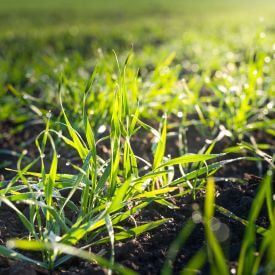Wheat Topdress
Mar 01, 2020

Another decade is here and I don’t think many are sad about that. Fall of 2018 through 2019 was a real challenge for a lot of growers in this country. Locally, we were fortunate to get our crops in and out. We did have enough fall and winter moisture to get our wheat out of the ground and going. While there isn’t a lot of top-growth there, the tiller counts seems really strong. We have some global production issues occurring in wheat right now, and domestically acres seem to be declining nearly every year. I am hopeful that once we get through this Coronavirus there may be some upside for winter wheat and good reason to invest in this crop this spring.
We know all about Kugler 342C which has a variety of essential nutrients specific to wheat for top-dress applications. It is a blend of Nitrogen, Potassium, Sulfur, Zinc, and Chloride. Nitrogen requirements on winter wheat are approximately 2 lbs/bu. We do get a nitrogen bump form spring applied N being worth more than fall applied as a greater percentage is used for spikelet formation. Sulfur and Potassium availability can come into question in more no-till environments. We have observed Sulfur deficiency in recent years and while K deficiencies are rare in our soils, availability of K is being more investigated in no till environments due to the nutrient’s immobility in the soil. Chloride is known to be a fundamental component to disease tolerance and photosynthesis in high yielding wheat. (Kugler 342C analysis is: 20# Nitrogen; 3# Potassium; 4# Sulfur; 5# Chloride; & 0.1# Zinc)
In past years we have seen some amplified leaf burn when mixing UAN sources and sulfonylurea herbicides (Finesse, Amber, Olympus, and Powerflex) at top-dress. Quelex herbicide should also be considered as it has a short rotational window to most crops as there may be some uncertainty on later planted wheat. We do need to watch how much Nitrogen we are spraying on wheat in the spring especially if temperatures get relatively high for top-dress timing. I don’t like to recommend over 50% of the total carrier be fertilizer. XRN can help fill that gap as a 70% slow-release that does not burn tissue and is a better option mixed with herbicide or fungicide in the spring.
Copper is a nutrient that has been discussed in the past 10 years. It is an immobile micronutrient that aids in pollen tube formation. It also is an essential cell component and key in protein synthesis. An effective method of applying has been somewhat challenging. We have a foliar form called MAX-IN Copper that can be tank mixed with other top-dress herbicides and fertilizers at a use rate of 8 oz/ac. Steady yield responses of 5 bu/ac have been observed with MAX-IN Copper.
Midway Co-op is launching a top-dress special. Apply 5 gal 342C + 1-2 gal XRN + 8 oz MAX-IN Copper along with your herbicide and fungicide of choice (TopGuard or Priaxor) and get application discounts as low as $4/ac with no money due till August. Talk to your local Midway Co-op branch manager or agronomist for details on our 2020 Green-up Program.